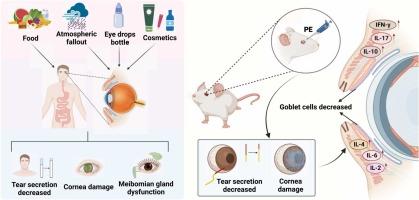Identification of Microplastics in Human Tear Fluid and Meibum: Implications for Dry Eye Disease Pathogenesis
IF 12.2
1区 环境科学与生态学
Q1 ENGINEERING, ENVIRONMENTAL
引用次数: 0
Abstract
Microplastics (MPs) are emerging environmental pollutants that are increasingly being detected in various human tissues. However, their impact on ocular health is underexplored. This study investigated the presence of MPs in tear fluid and meibum of 45 patients with dry eye disease (DED). Various examinations were conducted, including the Schirmer I test, fluorescein tear film break-up time (FBUT) and other dry eye-related assessments. MPs were identified in the tear fluid and meibum and were categorized into five distinct types, with polyethylene (PE) being the most predominant. Notably, PE levels exhibited significant correlations with key DED parameters, such as Schirmer I test scores and FBUT. In in vitro studies, PE exposure reduced the viability and induced apoptosis of human corneal epithelial cells and conjunctival epithelial cells in a dose-dependent manner. In mouse models, topical exposure to PE drops, which imitate airborne PE exposure, induced typical dry eye signs, reduced goblet cell numbers, and triggered conjunctival inflammation. PE-treated meibomian glands exhibited changes, but these changes were not statistically significant, possibly because of the limited duration of the study. This study is the first to confirm the presence of microplastics (MPs) in human tear fluid and meibum while also offering novel insights into the potential pathogenic effects of airborne MP exposure on ocular health.

求助全文
约1分钟内获得全文
求助全文
来源期刊

Journal of Hazardous Materials
工程技术-工程:环境
CiteScore
25.40
自引率
5.90%
发文量
3059
审稿时长
58 days
期刊介绍:
The Journal of Hazardous Materials serves as a global platform for promoting cutting-edge research in the field of Environmental Science and Engineering. Our publication features a wide range of articles, including full-length research papers, review articles, and perspectives, with the aim of enhancing our understanding of the dangers and risks associated with various materials concerning public health and the environment. It is important to note that the term "environmental contaminants" refers specifically to substances that pose hazardous effects through contamination, while excluding those that do not have such impacts on the environment or human health. Moreover, we emphasize the distinction between wastes and hazardous materials in order to provide further clarity on the scope of the journal. We have a keen interest in exploring specific compounds and microbial agents that have adverse effects on the environment.
 求助内容:
求助内容: 应助结果提醒方式:
应助结果提醒方式:


